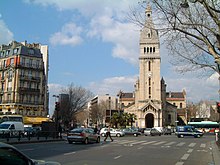St-Pierre de Montrouge
The parish church of St-Pierre de Montrouge is a church in the 14th arrondissement of Paris . It is on Place Victor et Hélène Basch in the Petit-Montrouge district . The church, designed by Emile Vaudremer , was built between 1863 and 1872 in neo-Romanesque style.
history
The area of today's Petit-Montrouge originally did not belong to Paris, but to the municipality of Montrouge. To the north-east of the town center there was a small settlement with a few houses, to which a simple brick chapel Saint-Pierre belonged since 1838 . This chapel was located north of the current church of St-Pierre de Montrouge in the area between Rue Thibaud and Passage Rimbaud . In 1848 it was decided to build a larger church, for which the financial means were initially lacking.
As part of the urban renewal of Paris by Baron Georges-Eugène Haussmann , the northern part of Montrouge was incorporated into the newly created Parisian 14th arrondissement in 1860. As in large parts of the city, new boulevards were laid out in the now Petit-Montrouge district. At today's Place Victor et Hélène Basch , at the intersection of the Rue d'Alésia with the Chaussée du Maine (today: Avenue du Maine ) and the Route d'Orléans (today: Avenue du Général Leclerc ), a piece of land in the shape of a pointed triangle was built, which was chosen as the construction site for the new construction of St-Pierre de Montrouge .
The building was financed by the French state, as the Napoleon III government . tried to secure the votes of Catholics by promoting church buildings and to improve relations with the Vatican. Church buildings also served to upgrade the new city district. The city administration of the 14th arrondissement commissioned the architect Emile Vaudremer with the construction of the church, which was largely completed in 1870. In the Franco-Prussian War of 1870/71, the church was located near the front line during the siege of Paris . During this time the church tower served as a lookout point for enemy observation and the nave was used as a hospital. During this time, the painting Effet de neige à Petit-Montrouge by Édouard Manet , which shows the church in the center of the picture, was created. The church was finally completed in 1872.
architecture
In 1862, Vaudremer presented a design in the neo-Romanesque style based on buildings from the 11th and 12th centuries. Models for neo-Romanesque church buildings in France were the church of Saint-Paul in Nîmes (1849) by Charles-Auguste Questel , as well as the Paris churches of Saint Lambert de Vaugirard (1854) by Paul Naissant and Saint François Xavier (1861) by Joseph Uchard . Because of the shape of the property, Vaudremer at St-Pierre de Montrouge opted for an elongated nave with a wide but short transept. At the top of the property on Rue d'Alesia rises the narrow portal with the 58-meter high church tower. The 70 meter long nave ends with an apse to which two chapels are attached. There are also chapels at the end of the transept.
Furnishing
The interior, with its floor decorated with mosaics, is reminiscent of early Christian basilicas and is modeled on the Roman churches of Santa Maria Maggiore and Saint Paul Outside the Walls , which Vaudremer had seen while studying in Rome. At the intersection of the nave and the transept, the altar is located below the crossing tower, above which there is a ciborium resting on four columns . The design for this comes from Henri-Charles Maniglier , who also created the bronze sculpture of Simon Petrus - the namesake of the church.
The few paintings in the interior include the depictions of Joseph and the Apostle John in the axis chapels of the transept. The pictures created by Eugène Capelle in 1869 on a golden background are reminiscent of Byzantine models. In the apse there is the mosaic of a blessing Christ, which was renewed in the 1930s by the painter Barillier. The church windows show stained glass from the workshops of Lauren-Gsell and Eugène-Stanislas Oudinot , which show stations from the life of Christ and the Virgin Mary.
Organs
The church has two organs : a main organ and a choir organ. A first organ was built in 1868 by Charles Spackman Barker , which was overhauled by Joseph Merklin in 1892 . Further alterations followed in 1917, 1924 and 1935 by Gutschenriter and in 1951 by Beuchet-Debierre from Nantes. The main organ has 43 stops on three manuals and pedal with electric action and the following disposition :
|
|
|
|
||||||||||||||||||||||||||||||||||||||||||||||||||||||||||||||||||||||||||||||||||||||||||||||||
-
Couple:
- Accouplements: II / I 8 ′; III / I 16 ′, 8 ′ and 4 ′; III / II 8 ′ and 16 ′.
- Tirasses : I, II and III.
- Playing aids : 4 fixed combinations, 1 free combination, appels d'anches for each manual.
Your titular organists were:
- circa 1862: Guillaumot
- 1892-1897: A. Mahaut
- 1897–1901: Henri Mulet
- 1901-1933: M. Blazy
- 1934-1945: Jean Langlais
- 1955–1973: Jean-Jacques Grunenwald
- Since 1977: J. Person
literature
- Jacques Hillairet: Dictionnaire historique des rues de Paris . Edition de Minuit, 1963 Paris, ISBN 2-7073-0092-6
- Isabelle Loutrel: St. Pierre de Montrouge . In La Voix du 14ème , local paper of the 14th arrondissement
Web links
- Église Saint-Pierre de Montrouge in the Base Mérimée of the French Ministry of Culture (French)
- Website of the parish of St-Pierre de Montrouge (French)
Coordinates: 48 ° 49 ′ 43.1 " N , 2 ° 19 ′ 37.3" E




